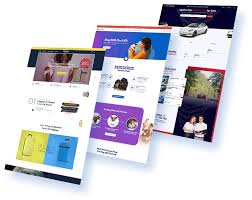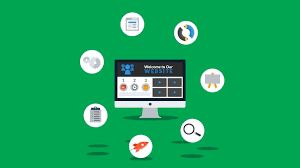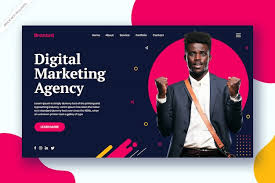Web Design Services: The Key to Building a Strong Online Presence
In today’s digital age, having a strong online presence is crucial for businesses of all sizes. Your website is often the first point of contact with potential customers, and it needs to make a lasting impression. That’s where web design services come in.
Web design services encompass everything from creating a visually appealing website to ensuring that it is user-friendly and easy to navigate. Here are some of the key benefits of investing in professional web design services:
A Professional Look and Feel
Your website is a reflection of your brand, and you want it to look professional and polished. A professional web design team can create a custom website that aligns with your brand identity and showcases your products or services in the best possible light.
Improved User Experience
A user-friendly website is essential for keeping visitors engaged and encouraging them to explore further. A well-designed website should be easy to navigate, with clear calls-to-action that guide visitors towards making a purchase or contacting you for more information.
Increased Search Engine Visibility
Search engine optimization (SEO) is an important aspect of web design services. By optimizing your site for search engines, you can improve your visibility in search results and attract more relevant traffic to your site.
Mobile Responsiveness
With more people accessing websites on their mobile devices than ever before, it’s essential that your site is mobile-responsive. This means that it adjusts automatically to fit the screen size of any device, providing an optimal viewing experience for all users.
Competitive Edge
Investing in professional web design services can give you a competitive edge over other businesses in your industry. A well-designed website can help you stand out from the crowd and position yourself as a leader in your field.
In conclusion, professional web design services are essential for building a strong online presence that attracts customers and drives business growth. By working with an experienced web design team, you can create a custom website that aligns with your brand identity and meets the needs of your target audience. So why wait? Start investing in your online presence today!
Answers to 8 Common Questions About Web Design Services
- What services do you offer for web design?
- How much does web design cost?
- What are the benefits of using a professional web designer?
- What is the process for working with a web designer?
- How long does it take to design a website?
- Do you provide ongoing website maintenance and support?
- Can I see examples of your previous work in web design?
- Are there any special requirements or considerations when designing a website for mobile devices?
What services do you offer for web design?
We offer a wide range of web design services, including website strategy and planning, custom website design, website development, content management systems (CMS), e-commerce solutions, search engine optimization (SEO) services, website maintenance and support, and hosting. We also offer additional services such as logo design, copywriting, and social media integration.
How much does web design cost?
The cost of web design services can vary greatly depending on a number of factors, including the complexity of the project, the level of customization required, and the experience and location of the web design team.
For a basic website with a few pages and minimal customization, you can expect to pay anywhere from $500 to $2,000. However, for more complex projects that require custom functionality or extensive design work, the cost can range from $5,000 to $20,000 or more.
It’s important to keep in mind that while cost is certainly a factor when choosing a web design team, it should not be the only consideration. It’s also important to consider factors such as experience, portfolio, and customer reviews when selecting a web design team.
Additionally, many web design teams offer different pricing packages depending on your specific needs. For example, some may offer hourly rates for smaller projects or fixed pricing for larger projects.
Ultimately, the best way to determine the cost of web design services is to reach out to several different web design teams and request quotes based on your specific project requirements. This will give you a better idea of what you can expect to pay and help you make an informed decision about which team is right for you.
What are the benefits of using a professional web designer?
There are several benefits to using a professional web designer for your website needs. Here are some of the most important ones:
Custom Design
A professional web designer can create a custom design that aligns with your brand identity and meets the unique needs of your business. This ensures that your website stands out from the competition and reflects the personality of your brand.
User Experience
A professional web designer knows how to create a user-friendly website that is easy to navigate, with clear calls-to-action that guide visitors towards making a purchase or contacting you for more information. This improves the overall user experience and encourages visitors to stay on your site longer.
Search Engine Optimization (SEO)
Professional web designers have experience with SEO techniques, which can help improve your website’s visibility in search engine results pages (SERPs). This means more potential customers will find your site when searching for keywords related to your business.
Cross-Platform Compatibility
A professional web designer will ensure that your website is compatible with all devices and platforms, including desktops, laptops, tablets, and mobile phones. This ensures that all users have access to your site regardless of their device or platform preference.
Time-Saving
Hiring a professional web designer saves you time as they take care of all aspects of website development, from design to launch. This allows you to focus on other aspects of running your business while knowing that an expert is handling your website needs.
Technical Support
Professional web designers provide technical support after launching the website. They can help troubleshoot any issues that arise and ensure that everything runs smoothly in the long term.
In conclusion, hiring a professional web designer is essential for creating a custom website that aligns with your brand identity and meets the unique needs of your business. A well-designed website improves the user experience, increases search engine visibility, and is compatible with all devices and platforms. Plus, it saves you time and provides technical support after launch.
What is the process for working with a web designer?
Working with a web designer can be an exciting process, but it can also be daunting if you’re not sure what to expect. Here’s a breakdown of the typical process for working with a web designer:
Consultation and Discovery
The first step in working with a web designer is to schedule a consultation to discuss your needs and goals for your website. During this phase, the designer may ask questions about your target audience, brand identity, and the features you’d like to include on your site.
Proposal and Contract
Once the designer has a clear understanding of your needs, they will provide you with a proposal outlining the scope of work and pricing. If you agree to move forward, you’ll sign a contract that outlines the terms of the project.
Design Mockups
The next step is for the designer to create mockups or wireframes that outline the layout and design of your website. This is an opportunity for you to provide feedback and make any necessary changes before moving forward.
Development
Once you’ve approved the design mockups, the designer will begin developing your website using HTML/CSS/JavaScript or another web development framework such as WordPress or Shopify if it’s an e-commerce site. During this phase, you may have access to view progress updates on a staging environment.
Content Creation
While development is underway, you’ll need to provide content such as copywriting, images/videos, and other media assets that will be used on your website.
Testing and Launch
Before launching your site, it’s important to test it thoroughly for functionality and compatibility across different devices/browsers. Once everything has been tested thoroughly then it’s ready for launch!
Maintenance and Support
After your site is live, your designer will provide ongoing maintenance and support to ensure that it continues to function properly and remains up-to-date with the latest web technologies. You may also have access to analytics reports and other tools to track the performance of your website.
In conclusion, working with a web designer involves several phases, from initial consultation through design, development, testing, and launch. By following this process, you can ensure that your website meets your needs and goals while providing an exceptional user experience for your visitors.
How long does it take to design a website?
The time it takes to design a website can vary greatly depending on the complexity of the project and the scope of work involved. A simple website with a few pages and basic functionality can be designed in as little as a few days, while a more complex website with custom features and integrations can take several weeks or even months to complete.
Factors that can affect the timeline for website design include:
– The size of the website (number of pages and content)
– The level of customization required
– The complexity of any special features or functionality
– The availability and responsiveness of the client for feedback and approvals
– The workload and availability of the web design team
It’s important to note that designing a website is not just about creating an aesthetically pleasing layout. It also involves developing a user-friendly interface, optimizing for search engines, testing for usability and accessibility, and ensuring compatibility across different devices and browsers.
To ensure that your website is designed efficiently, it’s important to work closely with your web design team from the outset. This includes providing clear guidelines on your brand identity, target audience, and goals for the website. Regular communication throughout the project will help ensure that any issues are addressed promptly, which can help keep the project on track.
Ultimately, it’s important to prioritize quality over speed when it comes to designing a website. Rushing through the process can lead to mistakes or oversights that could impact your online presence in the long run. By working with an experienced web design team and allowing sufficient time for development, you can create a high-quality website that meets your needs both now and in the future.
Do you provide ongoing website maintenance and support?
Yes, we do provide ongoing website maintenance and support. We offer a range of services to keep your website running smoothly, such as troubleshooting, updating content, security monitoring, and more.
Can I see examples of your previous work in web design?
Yes, absolutely. You can view our portfolio of web design projects on our website.
Are there any special requirements or considerations when designing a website for mobile devices?
Yes, there are several special requirements and considerations when designing a website for mobile devices. Here are some of the most important ones:
Responsive Design
A responsive design is essential for websites that will be viewed on mobile devices. This means that the website should be designed to automatically adjust to fit the screen size of any device, whether it’s a smartphone or a tablet. This ensures that the user has an optimal viewing experience and can easily navigate the site.
Simple Navigation
Mobile users have limited screen space and may be using their device with one hand, so it’s important to keep navigation simple and easy to use. This means using clear labels for menu items and keeping the number of menu items to a minimum.
Fast Loading Times
Mobile users expect websites to load quickly, so it’s important to optimize images and other media for fast loading times. This can include compressing images, minimizing code, and reducing server response time.
Thumb-Friendly Design
Since mobile users often use their devices with one hand, it’s important to design the website with this in mind. This means placing buttons and other interactive elements within easy reach of the user’s thumb.
Avoid Pop-Ups
Pop-ups can be frustrating for mobile users since they take up valuable screen space and can be difficult to close on a small device. It’s best to avoid pop-ups altogether or use them sparingly.
Readable Text
Text should be easy to read on a small screen, so it’s important to choose a font size that is large enough for mobile users. It’s also important to use high-contrast colors between text and background for maximum legibility.
In conclusion, designing a website for mobile devices requires careful consideration of factors such as responsive design, simple navigation, fast loading times, thumb-friendly design, avoiding pop-ups, and readable text. By keeping these requirements in mind, you can create a mobile-friendly website that provides an optimal user experience for your visitors.




